
Consider the bat a baton, handed from a distinctly American sports legend on his last legs to a youngster about to embark on a distinctly American adulthood. Just don't call it pure Hollywood: Bing Russell knew fact from fiction, and the story of Lou Gehrig giving him the last bat he used to hit a home run is reality without a show, not yet anyway.
SCP Auctions is currently taking bids on the bat, and it's projected to be one of most valuable baseball pieces ever sold. How it went from Gehrig's python-like grip to the trembling hands of a 12-year-old boy in the dugout to safekeeping for more than 70 years is a fascinating tale, one that Bing's children (who include veteran leading man Kurt Russell) and grandchildren (who include former major leaguer Matt Franco) want made public.
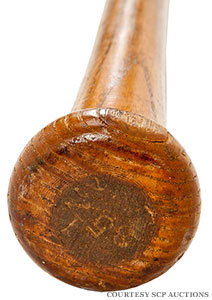
Bing died in 2003 at 76. Kurt starred in the acclaimed sports movie "Miracle" in 2004. Matt's 20-year pro career ended in 2006. All the while, the bat rested under an umbrella stand in the home of Kurt's sister and Matt's mom, Jill Franco.
Matt visited her earlier this year, and there it was. He lifted the bat, so heavy, so formidable, just the way he remembered the first time he held it as a kid. He thought about his grandfather, the man the family called "Pa," how he'd traveled to every one of the dozen or so minor and major league cities Matt played in just to watch his at-bats. The pride he felt. The tales he told.
"It's time the world knows Pa's story, and the best way to tell it by getting this bat to someone who can display it," Matt said to his mom.
They called Kurt and talked it over. The decision came down to letting the lumber breathe.
Get it out from under the umbrella stand and into the sunlight. Let it become a conduit connecting Lou Gehrig's stately greatness to Bing Russell's rollicking life to new owners who ideally would display their acquisition. The story might spread.
Turns out it's not the first auction the bat's been through. Shortly after Bing turned 70, he looked around and decided it was time to de-clutter his house and disperse the possessions. Memorabilia, somebody called it. He said, no, it's a lifetime. He'd spent his adolescence in the Yankees dugout and then became an actor, owner of a ballclub, father of an even more famous actor, and grandfather of a big leaguer.
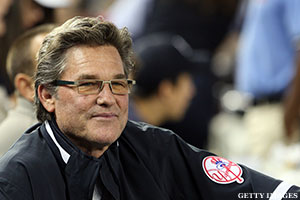
Yes, Bing did a whole lot and accumulated magnificent memories. And because he'd taken a piece with him at every turn, his home was full of interesting stuff. So he and his wife, Lou, summoned their four children and said let's have some fun, let's have a family auction.
It was a draft, really, youngest to oldest. Daughters Jamie and Jody treasured their dad's roles as the deputy sheriff in "Bonanza," as Robert in "The Magnificent Seven" and his dozens of other parts in TV shows and films. Their picks reflected that. Kurt, whose own acting career in films ranging from "Backdraft" to "Silkwood" to "Tombstone" overshadowed a deep love of baseball, took seats from the original Yankee Stadium given to his dad by pitcher Lefty Gomez, who'd been a father figure to Bing.
Jill's first pick was an old wooden sign from a lake in Maine where the family vacationed when she was a little girl. When it came to keepsakes, sentiment won out over resale value. Jamie, Jody and Kurt made their second-round picks and still the Gehrig bat leaned against the wall. Maybe Jill's siblings deferred because Matt played for the New York Mets at the time.
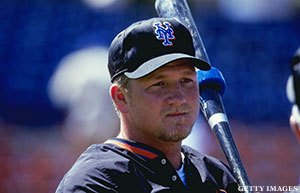
Before she took her second pick Jill asked why she had the last pick every round just because she was the oldest. Bing agreed that the draft should reverse each round thereafter. And that gave Jill two picks in a row.
She took a different bat to end the second round, one Joe DiMaggio had used that was signed by the entire 1941 Yankees and given to Bing near the end of his eight-year childhood association with the team. He wasn't a bat boy or a clubhouse attendant, more of an errand boy the players liked having around. He'd sneak them peanuts, even hot dogs, against the wishes of manager Joe McCarthy, who forbade eating during ballgames. Bing was home-schooled, so he was able to travel with the team and do whatever the players asked. He sat in the dugout during games.
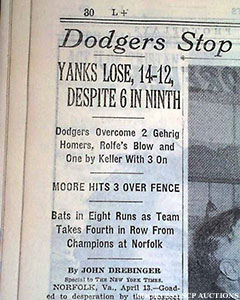
The family auction continued, and with her newly acquired first pick of the third round, Jill selected the bat Gehrig had handed her father upon returning to the dugout April 13, 1939. It was the Iron Horse's second homer of the game, an exhibition against the Brooklyn Dodgers in Norfolk, Va. Already weakened by amyotrophic lateral sclerosis, what would come to be known as Lou Gehrig's disease, he played only eight games when the regular season began before retiring. He died two years later at 37.
"My grandfather would bring out that bat every time we had people over and the conversation turned to baseball," Matt Franco says. "He'd pass it around the table and he'd tell stories about all the guys on those teams."
The coolest aspect to Kurt Russell was that the bat was handed directly from Gehrig to Bing. His dad's story never changed: "The bat boy, Timmy, picked it up while Lou was circling the bases and gave it to Lou when he touched the plate. Lou carried it back to the dugout and handed it to me."
It's all been verified. SCP Auctions sent the bat to a third-party authenticator that confirmed it was one of the last professional models shipped to Gehrig by Hillerich & Bradsby. The venerable bat-making company keeps meticulous records, and an invoice shows the shipment of four bats was delivered in August, 1938. It was Gehrig's last order.
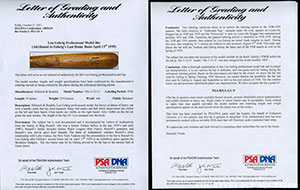
The highest auction price for a bat was $1.265 million in 2005 for the one Babe Ruth used to hit the first home run at old Yankee Stadium on opening day in 1923. Shoeless Joe Jackson's Black Betsy is the second highest, selling for $577,610 in 2001, and Kirk Gibson's 1988 World Series home run bat went for $576,000 last year.
SCP managing director Dan Imler puts the Gehrig bat in the same league as the Jackson and Gibson bats: "This is the single finest Lou Gehrig artifact we’ve witnessed in the thirty-two year history of our company. It has all the characteristics of a record-setting piece."
The auction ends Nov. 19. Two other of Bing's bats are also taking bids: The one DiMaggio used that the 1941 Yankees signed and one used by Babe Dahlgren, who replaced Gehrig at first base in 1939.
Bing grew up in St. Petersburg and would hang out during spring training at the Yankees facility there. One day in 1935 at age 9 he outraced other kids for a foul ball only to have to fight them off to keep it. Lefty Gomez, the ace of the Yankees' pitching staff, noticed the kids scuffling, picked up Bing by the collar and said, "Kid, you'll never have to fight for a ball the rest of your life."
Bing spent the next eight years with the team and was in the dugout for six World Series. Gomez became a father figure to him, saying, "Bing was the only person who took it harder than I did when I lost." Although Gehrig would shoot him a grin and a nod, Bing kept a respectful distance because he was in awe of the quiet superstar first baseman.
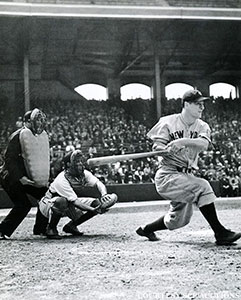
When spring training rolled around in 1939, it was clear something was wrong with Gehrig. Bing would give Gomez a quizzical look whenever Gehrig stumbled or fumbled a ground ball. Gomez would return a stare as if to say, "You didn't see that." Nobody knew anything about the incurable, fatal neuromuscular disease ALS, and to see the powerful Gehrig losing his strength and coordination so rapidly was horrifying.
The Yankees were on their way from Florida to New York for the start of the regular season, making stops up the Eastern seaboard for exhibitions. They played a doubleheader against the Dodgers on April 14 and somehow Gehrig summoned the strength to belt two home runs. He handed Bing the bat after the second blast.
Two years later Bing was given the autographed DiMaggio bat, and a year after that he and his parents moved away from Florida, ending his association with the Yankees. He maintained a lifelong friendship with Gomez (left in the picture below with Bing), and was at his bedside when he died in 1989.
Bing went to Dartmouth, then played a season and a half of Class D pro ball with the Carrollton Hornets of the Georgia-Alabama League before heading to Hollywood and embarking on a career as an actor.
Bing raised his family in the Los Angeles suburb of Thousand Oaks and got his son into acting at an early age. Kurt starred in the TV show "The Travels of Jaimie McPheeters" at age 12 and as an adolescent appeared in shows ranging from "Gilligan's Island" to "The Virginian" to "Lost in Space." Kurt's film career took off when he signed a 10-year deal with Disney, but he made time for baseball, playing second base for Thousand Oaks High.
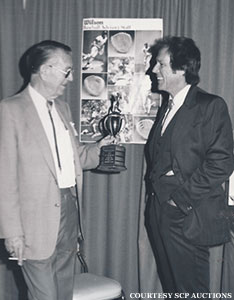
Bing jumpstarted Kurt's pro baseball career in 1973 by purchasing the Portland Mavericks, the only team unaffiliated with a major league franchise in the Class-A Northwest League. It was a labor of love for five years.
Bing hired the first female general manager in professional baseball one year, and the first Asian American GM the next. His buddy Hank Robinson, like Bing a character actor with a love of baseball, was his first manager. The Mavericks set Northwest League attendance records and won two division championships. Their mantra was a three-letter word. Not "win, but "fun."
Everybody thought "Ball Four" author and pitcher Jim Bouton was washed up when he joined the Mavericks in 1977, but he perfected the knuckleball and made it back to the major leagues at age 39. The team was forced to leave Portland after that season because the Triple-A Pacific Coast League wanted a team there. Bing was paid $206,000 on his way out.
Meanwhile Kurt's playing career ended at Double-A El Paso when he suffered a torn rotator cuff turning a double play. He batted .292 in three seasons, then had one final at-bat with the Mavericks in 1977 just for old times sake. He'd gone back to acting by then and soon landed leading-man roles in films such as "Escape from New York."
"Baseball is really the family business that nobody knows about because our other business was sort of out there in the public and seen by a lot more people," Kurt says.
Bing soon had another baseball adventure to pursue. Matt Franco was a seventh-round pick of the Chicago Cubs out of Westlake High School near Thousand Oaks in 1987 and began a slow, steady climb through the minor leagues that culminated in an eight-year major league career beginning in 1995.
Bing and Lou followed their grandson at every stop. They even bought a summer apartment in Des Moines when Matt spent parts of three seasons with the Triple-A Iowa Cubs. Matt was traded to the Mets in April 1996, and although he became an excellent big league utility player and pinch-hitter, he spent considerable time at the Mets' Triple-A affiliate in, of all places, Norfolk.
On many summer Virginia evenings Bing would settle into a seat near the dugout and watch his grandson get his four at-bats. And his mind would drift back to 1939 and the day in Norfolk that Lou Gehrig handed him his bat, the last he used to blast a baseball out of a ballpark.
-- To participate in the auction, go to SCP Auctions.
-- Steve Henson is a senior editor and columnist at Yahoo! Sports. He can be reached at henson@yahoo-inc.com. Follow him on Twitter @HensonYahoo.




